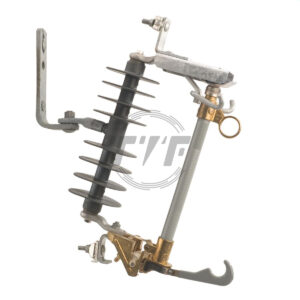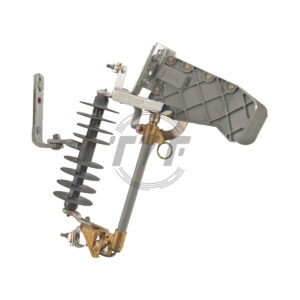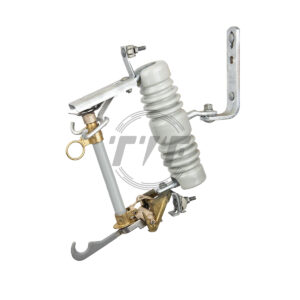
Drop-Out Fuse Cutout
Fuse Cutout Manufacturer
TTF Power manufactures and supplies fuse cutouts and fittings for overhead power distribution systems. A drop-out fuse is an electrical safety device used on utility poles to protect electrical equipment and systems from damage during overloading or short-circuits. These fuses are designed to “drop out” or disconnect the circuit if an excessive current flows through the system, effectively breaking the circuit and preventing further damage. The drop-out fuse typically consists of a metal or ceramic casing, a fuse element inside the casing, and a mechanism that allows the fuse to disconnect from the circuit when the current reaches a specified level. This mechanism can be a spring-loaded arm, a melted fuse link, or some other type of release mechanism. The drop-out fuse is an important component in the overall electrical safety system, helping to ensure that electrical equipment and systems are protected from damage and dangerous electrical conditions.
Components of drop-out fuses
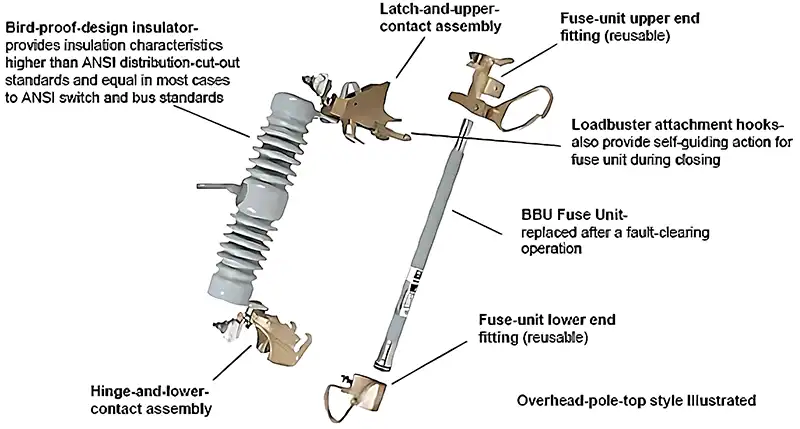
A drop-out fuse typically consists of the fuse element, casing, operating mechanism, terminal connections and indicator.
- Fuse element: This is the part of the fuse that actually carries the electrical current and melts when the current exceeds a certain level. The fuse element can be made of metal, ceramic, or other materials, and is designed to interrupt the flow of current when it melts.
- Casing: The casing is the outer shell that contains and protects the fuse element. It can be made of metal, plastic, or other materials, and is typically weather-resistant to protect the fuse from the elements.
- Operating mechanism: This is the part of the fuse that causes the fuse to disconnect from the circuit when the current exceeds a certain level. It can be a spring-loaded arm, a melted fuse link, or some other type of release mechanism, depending on the design of the fuse.
- Terminal connections: These are the connections that allow the fuse to be connected to the electrical system. They can be screw terminals, plug-in connections, or some other type of connection, depending on the design of the fuse.
- Indicator: Some drop-out fuses also have an indicator, such as a flag or a light, that shows when the fuse has “dropped out” and disconnected the circuit. This allows the utility crew to easily determine if a fuse has blown and needs to be replaced.
These are the basic components of a drop-out fuse, and the exact design and configuration of the fuse may vary depending on the specific requirements of the electrical system and the manufacturer.
Applications of drop-out fuses
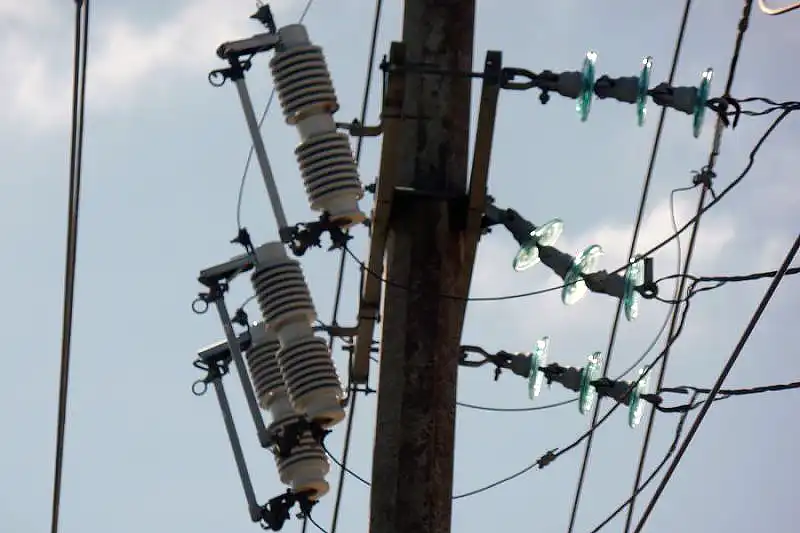
Drop-out fuses are commonly used in a variety of electrical systems and applications, such as power distribution systems, residential electrical systems, motors and other electrical equipment, and others.
- Power distribution systems: Drop-out fuses are widely used in power distribution systems, such as those found in utility companies and large industrial facilities, to protect against overloading and short-circuits.
- Residential electrical systems: Drop-out fuses are often used in residential electrical systems to protect individual circuits and appliances from overloading.
- Motors and other electrical equipment: Drop-out fuses can be used to protect motors and other electrical equipment from overloading and short-circuits.
- Lighting circuits: Drop-out fuses can be used in lighting circuits to protect the lighting fixtures, wiring, and other components from overloading.
- Outdoor electrical systems: Drop-out fuses can be used in outdoor electrical systems, such as those found in parks and other public areas, to protect against overloading and short-circuits.
- Agricultural equipment: Drop-out fuses can be used in agricultural equipment, such as tractors and other machinery, to protect the electrical systems from overloading and short-circuits.
- Uninterruptible Power Supply (UPS) systems: Drop-out fuses can be used in UPS systems to protect the electrical components from overloading and short-circuits during power outages and other disruptions.
| Rated Voltage (kV) | Rated Current (A) | Breaking Current (A) | Impulse Voltage (BIL) | Power-Frequency Withstand Voltage (kV) | Leakage Distance (mm) |
|---|---|---|---|---|---|
| 15 | 100 | 10,000 | 125 | 45 | 350 |
| 15 | 200 | 12,000 | 125 | 45 | 350 |
| 24 | 100 | 8,000 | 150 | 65 | 540 |
| 24 | 200 | 10,000 | 150 | 65 | 540 |
| 30 | 100 | 6,000 | 170 | 70 | 700 |
| 30 | 200 | 8,000 | 170 | 70 | 700 |
Overall, drop-out fuses are used in a wide range of electrical systems and applications, and are chosen for their ability to protect against overloading and their relatively low cost compared to other types of protective devices.
Types of drop-out fuse
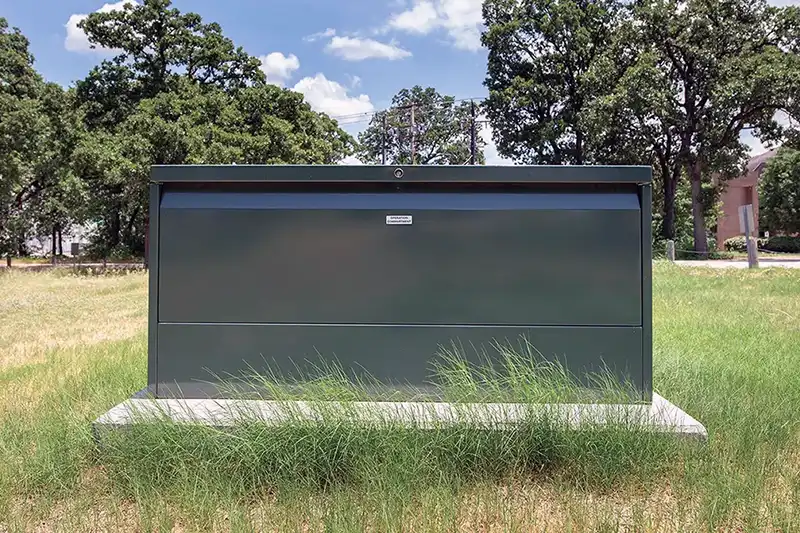
In an overhead power distribution network, the types of drop-out fuses typically used include:
- Cutout Fuses: Cutout fuses are used to protect transformers and other electrical equipment in an overhead power distribution network. They are designed to disconnect the electrical circuit in the event of an overloading or short-circuit condition and are typically installed at the point where the electrical equipment is connected to the power distribution network.
- Pad-Mounted Fuses: Pad-mounted fuses are housed in a metal enclosure that is mounted on a concrete pad. They are typically used in outdoor electrical systems, such as those found in residential and commercial power distribution networks. Some pad-mounted fuses may include features such as thermal protection, overcurrent protection, and surge protection to ensure reliable and effective performance in a range of electrical applications.
- Class R Fuses: Class R fuses are specifically designed for use in power distribution systems, including overhead power distribution networks. They are designed to handle high levels of current and are often used to protect large electrical equipment, such as transformers and motors. Class R fuses are relatively large and heavy, and are typically installed in fuse boxes or switchgear.
- Class J Fuses: Class J fuses are designed for use in low-voltage electrical systems, including overhead power distribution networks. They are typically used to protect motors, transformers, and other electrical equipment. Class J fuses are available in a range of current ratings and are commonly used in industrial and commercial electrical systems.
The specific type of drop-out fuse that is best suited for a particular application in an overhead power distribution network will depend on the specific requirements of the electrical system, including the current and voltage ratings, as well as the type and size of the electrical equipment that will be protected. It is important to consult with a qualified electrical engineer or technician to ensure that the appropriate type of drop-out fuse is selected for the specific application.
Installation of drop-out fuses
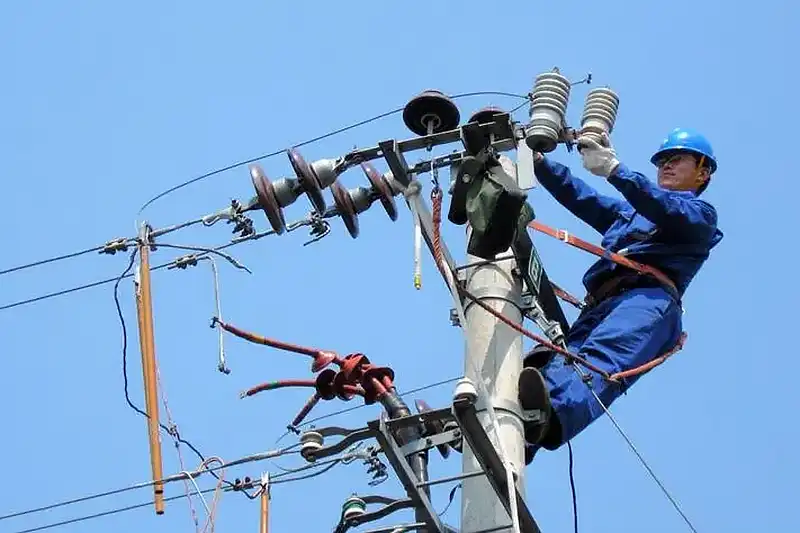
Installing a drop-out fuse involves the following steps:
- Turn off the power: Before installing the fuse, make sure to turn off the power to the electrical system to ensure that there is no danger of electrical shock or damage to the equipment.
- Identify the location: Choose a location for the fuse that is easily accessible and allows for easy connection to the electrical system. It should also be protected from the elements and have adequate clearance for maintenance.
- Mount the fuse: Mount the fuse to the pole or other support structure using the appropriate hardware, such as bolts or brackets. Make sure that the fuse is securely mounted and will not move or vibrate.
- Connect the terminals: Connect the terminals of the fuse to the electrical system using the appropriate connectors, such as screws or plugs. Make sure that the connections are secure and properly tightened.
- Check the connections: Check all the connections to make sure that they are secure and properly installed. Also, check the fuse element and the operating mechanism to make sure that they are properly positioned and functional.
- Restore power: Once the fuse is installed and all the connections have been checked, turn the power back on to the electrical system.
- Test the fuse: Finally, test the fuse to make sure that it is working properly. This can be done by intentionally overloading the circuit or by using a test instrument to simulate a fault condition. If the fuse does not “drop out” or disconnect the circuit, then the installation may need to be checked or adjusted.
It is important to follow the manufacturer’s instructions when installing a drop-out fuse, as different models may have different requirements and precautions. If you are not familiar with electrical systems or do not feel comfortable installing the fuse, it is recommended to seek the assistance of a qualified electrician.
Pros and cons of drop-out fuses
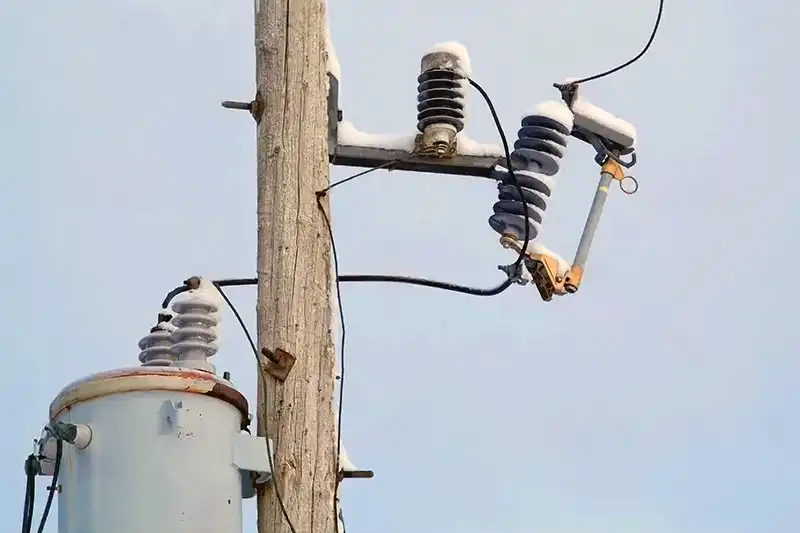
Pros
- Protects against overloading: Drop-out fuses are designed to disconnect the electrical circuit if an excessive current flows through it. This protects electrical equipment and systems from damage during overloading, which can occur due to a variety of reasons such as a power surge, a fault in the electrical system, or an increase in the load on the system.
- Improves safety: By disconnecting the circuit in the event of an overloading or short-circuit condition, drop-out fuses help to prevent dangerous electrical conditions and improve the overall safety of the electrical system.
- Easy to replace: If a drop-out fuse blows, it is relatively easy to replace it with a new one. This helps to minimize downtime and maintain the reliability of the electrical system.
- Cost-effective: Drop-out fuses are a cost-effective solution for protecting electrical equipment and systems against overloading and short-circuits. They are less expensive than other types of protective devices, such as circuit breakers, and can be easily replaced if they blow.
Cons
- Limited protection against short-circuits: While drop-out fuses are effective at protecting against overloading, they may not provide adequate protection against short-circuits, which can be caused by a direct connection between the live and neutral conductors.
- Maintenance: Drop-out fuses can require periodic maintenance, including checking and replacing fuses that have blown. This can be time-consuming and may result in downtime for the electrical system.
- Slow response time: Drop-out fuses can take some time to disconnect the circuit, which can result in a certain amount of damage to the electrical system before the fuse “drops out”. This can be especially problematic in situations where the overloading or short-circuit conditions are severe.
- Limited protection against low-level faults: Drop-out fuses may not be effective at detecting and disconnecting low-level faults, such as ground faults, which can result in a slow degradation of the electrical system over time.
Overall, drop-out fuses have some benefits and disadvantages, and the choice of using them depends on the specific requirements and conditions of the electrical system.
How to select the best drop-out fuses
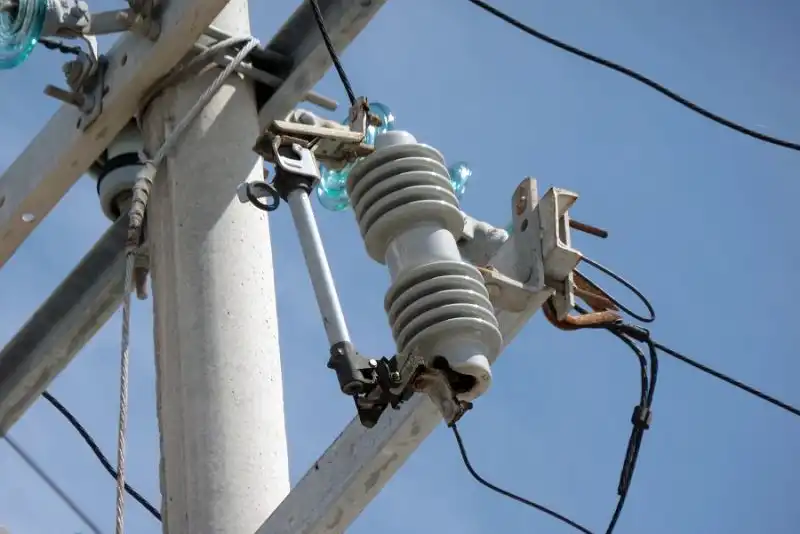
When choosing a drop-out fuse, there are several key factors to consider, including:
- Current rating: The current rating of the drop-out fuse must match the current capacity of the electrical system it will be protecting. It is important to choose a fuse with a current rating that is equal to or greater than the maximum current that will flow through the system.
- Voltage rating: The voltage rating of the drop-out fuse must match the voltage of the electrical system it will be protecting. It is important to choose a fuse with a voltage rating that is equal to or greater than the voltage of the system.
- Interrupting rating: The interrupting rating of the drop-out fuse indicates the maximum current that it can safely interrupt in the event of an overloading or short-circuit condition. The interrupting rating must be adequate for the electrical system it will be protecting.
- Response time: The response time of the drop-out fuse indicates how quickly it will disconnect the electrical circuit in the event of an overloading or short-circuit condition. A faster response time is generally preferred, as it can help to minimize damage to the electrical system.
- Compatibility: The drop-out fuse must be compatible with the electrical system it will be protecting. This includes ensuring that the fuse fits into the fuse holder and that the fuse and holder are rated for the same voltage and current.
- Cost: The cost of the drop-out fuse must be considered when making a purchasing decision. The cost will depend on the type and size of the fuse, as well as the manufacturer and supplier.
It is important to choose a drop-out fuse that is specifically designed for the type of electrical system it will be protecting and to consult with a qualified electrical engineer or technician to ensure that the fuse is appropriate for the specific application.
FAQs
What is a drop-out fuse?
A drop-out fuse is a type of electrical protection device that is designed to disconnect the electrical circuit in the event of an overloading or short-circuit condition. Drop-out fuses are typically used in electrical systems to protect equipment and to prevent damage to the electrical system in the event of a fault.
How does a drop-out fuse work?
A drop-out fuse works by breaking the electrical circuit in the event of an overloading or short-circuit condition. The fuse contains a metal element that melts when the current exceeds the fuse’s rated capacity. This melting of the metal element causes an interruption in the flow of current, which disconnects the electrical circuit and protects the electrical equipment and system.
What are the different types of drop-out fuses?
There are several types of drop-out fuses, including blade fuses, cartridge fuses, fusible links, Class R fuses, Class J fuses, and Class T fuses. The type of drop-out fuse that is best suited for a particular application will depend on the specific requirements of the electrical system, including the current and voltage ratings, as well as the type and size of the electrical equipment that will be protected.
What are the factors to consider when choosing a drop-out fuse?
When choosing a drop-out fuse, factors to consider include the current rating, voltage rating, interrupting rating, response time, compatibility, and cost. It is also important to ensure that the drop-out fuse is specifically designed for the type of electrical system it will be protecting and to consult with a qualified electrical engineer or technician to ensure that the fuse is appropriate for the specific application.
How should a drop-out fuse be installed?
The installation of a drop-out fuse typically involves connecting the fuse to the electrical system and mounting it in a fuse holder or fuse box. The specific installation process will depend on the type of drop-out fuse being used, as well as the type and size of the electrical system it will be protecting. It is important to follow the manufacturer’s instructions and to consult with a qualified electrical engineer or technician if necessary to ensure that the installation is performed correctly and safely.

